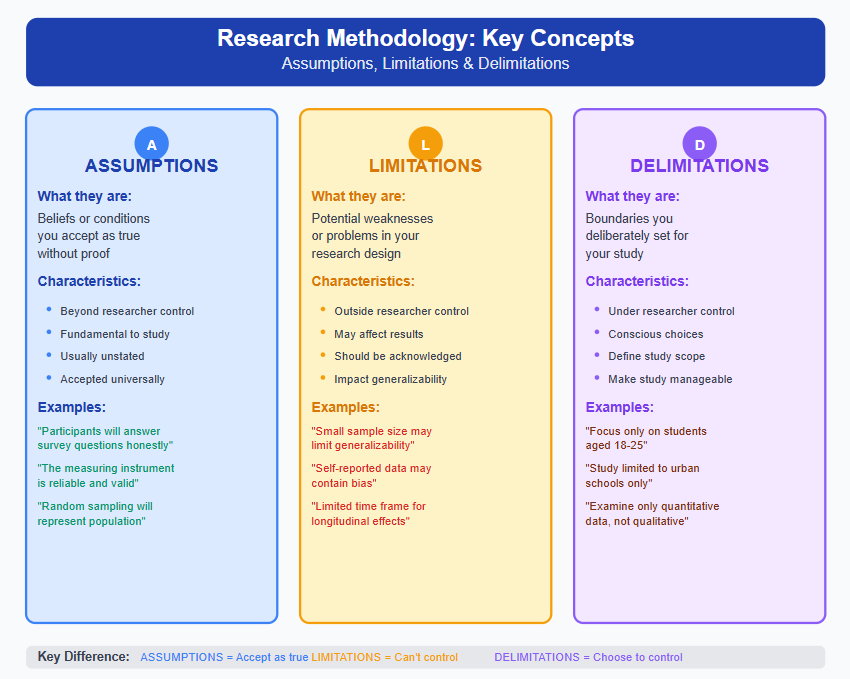The Basics of Assumptions in Research
- Assumptions are statements that the researcher chooses to assume something is accepted as true without absolute proof.
- Every dissertation, thesis, or academic paper contains common assumptions that give a basis for the research design.
- The researcher may assume that participants will provide truthful responses during surveys or data collection.
- An example is when a sample size is accepted as true without questioning whether it perfectly represents the population.
- Assumptions often relate to belief, behavior, and experience, which the researcher cannot directly measure but must accept as credible evidence.
- A theoretical framework is built on the concept that certain variables and factors influence finding and analysis.
Get Expert Dissertation Support
Achieve academic success with Elite Thesis Help. Our professional team provides tailored guidance on research, writing, and editing to strengthen your dissertation. Contact us today and transform challenges into confident results.
- The researcher uses qualitative, quantitative, or mixed-methods designs with the goal of achieving objective and analytical results.
- Science requires that assumptions be stated clearly so the reader can relate the claims to the context of the study.
- Without assumptions, the scope of research would be too restricted or reduced, making it difficult to reach a conclusion.
- For instance, a methodological assumption might state that the survey tool has reliability and credibility in measuring the variable.
- A cultural or geographic assumption could affect the generalizability of the finding.
- Theories may provide a universal explanation, but the researcher must acknowledge alternative assumptions that could also influence outcomes.
- Professional and scholarly writing requires that such assumptions are documented to direct the reader toward the framework of the study.
- Assumptions guide the analysis and help determine whether the conclusion is accurate, objective, and truthful within the boundary of the study.
- Ultimately, assumptions are a restriction and at the same time a strength, since they form the basis of the claim and allow the researcher to state conditions under which the theory may hold true without proof.
Assumptions in Research Example
The study assumes that young adults across diverse cultural contexts will provide truthful responses regarding their experiences of digital overload and emotional well-being. It further assumes that self-reported data on attention, memory, and psychosocial states accurately reflect actual neurocognitive and emotional processes. The research presumes that participants’ engagement with digital technologies is consistent enough to produce observable patterns across cultures. It is also assumed that standardized instruments and theoretical frameworks selected for analysis hold cross-cultural validity and reliability, enabling meaningful comparisons. Finally, the study assumes cultural differences will influence findings without undermining their overall credibility.
Limitations in a Research Study
- Limitations are the constraints or potential weaknesses that affect the scope and credibility of a study.
- A limitation is often beyond the researcher’s control and may reduce the generalizability of the finding.
- An example is a small sample size, which makes it harder to draw a universal inference.
- Methodological limitations may involve data collection, survey response, or design errors.
- Funding restrictions, geographic boundaries, or lack of data sources are also major constraints.
- The research design may have limits in handling every variable, which could affect the accuracy of analysis.
- Statistical limitations include low correlation strength, difference in response rates, or limited evidence to support a claim.
- In qualitative research, limitations might arise from participant behavior, belief, or cultural context that are difficult to analyze objectively.

- In quantitative research, a restriction may come from the theory or framework chosen, since theory may not fully fit the data.
- The goal is to be truthful and professional in acknowledging limitations so that the reader can accept the conclusion with awareness of its boundaries.
- Scholarly writing requires pointing out alternative explanations or factors that could influence results.
- For instance, a survey conducted in one geographic area may affect how the finding relates to other populations.
- Another instance could be the methodological choice of a qualitative design when a quantitative analysis might have provided stronger evidence.
- The researcher must document these limitations in the dissertation or paper to maintain reliability and credibility.
- By stating limitations, the researcher sets a clear boundary of what the study can and cannot accurately claim.
- Limitations are not failures; they are a direct part of science that shows where further research or alternative designs are needed.
Example of Limitations in a Research Study
This study faces limitations that may affect the generalizability of its findings. The reliance on self-reported data introduces potential biases, such as inaccurate recall or socially desirable responses, which may reduce reliability. Cultural diversity across participants may also complicate interpretation, as variations in digital habits and emotional expression could limit direct comparisons. The cross-sectional research design restricts the ability to establish causal relationships between digital overload and emotional dysregulation. Additionally, differences in digital infrastructure, funding, and participant availability may constrain data collection. Finally, neurocognitive processes are complex, and not all influencing variables can be fully controlled.
Delimitations in Research Study
- Delimitations are the boundaries that the researcher intentionally sets to restrict the scope of a study.
- Unlike limitations, they are within the researcher’s choice and control.
- Delimitations specify what the research design will and will not include.
- An example is selecting one population over another, or using a sample of students instead of the entire population.
- The researcher may assume that the sample size chosen is sufficient for analysis and generalizability.
- Delimitations are often tied to methodological definitions, such as the variables, concepts, and framework that shape the dissertation or thesis.
- By clearly stating delimitations, the researcher provides the reader with an understanding of the context and boundary of the study.
- They may restrict the geographic region, cultural setting, or timeframe under study.
- For instance, a survey may be directed only at one professional group, which affects the conclusion but ensures focus.
- Delimitations help reduce distractions, sharpen the goal, and maintain a scholarly and objective direction.
- They also improve credibility because the researcher shows awareness of what is outside the scope.
- Delimitations are essential for science because they ensure the research design remains manageable given funding, time, or data availability.
- An instance is choosing qualitative research when quantitative analysis is not possible within the resource constraint.
- Delimitations can include choice of variables, theoretical framework, and methodological definition of terms.
- They also influence the finding, since the design may highlight certain factors while ignoring alternative ones.
- Theories may suggest many correlations, but the researcher must define which are most relevant.
- Delimitations make the paper or document accurately reflect what the researcher intends to analyze and present as evidence.
- When well written, delimitations support professional academic writing by showing clear objectives, honest restrictions, and logical inference.
Example of Delimitations in Research
This study is delimited to young adults living in high-connectivity environments, thereby excluding populations such as adolescents, older adults, or those in low-connectivity regions. The research focuses specifically on neurocognitive processes—attention, memory, executive functioning—and psychosocial factors such as stress, anxiety, loneliness, and emotional regulation, rather than broader mental health conditions. Only selected cultural contexts are examined, based on feasibility and relevance, which restricts universal generalization. The study also delimits itself to cross-sectional survey and standardized instruments, excluding longitudinal or experimental designs. These choices were made to maintain clarity, manage scope, and ensure alignment with the research aim.
